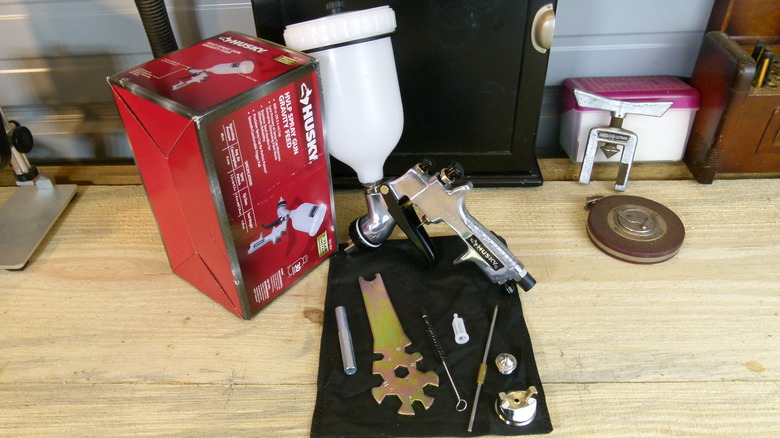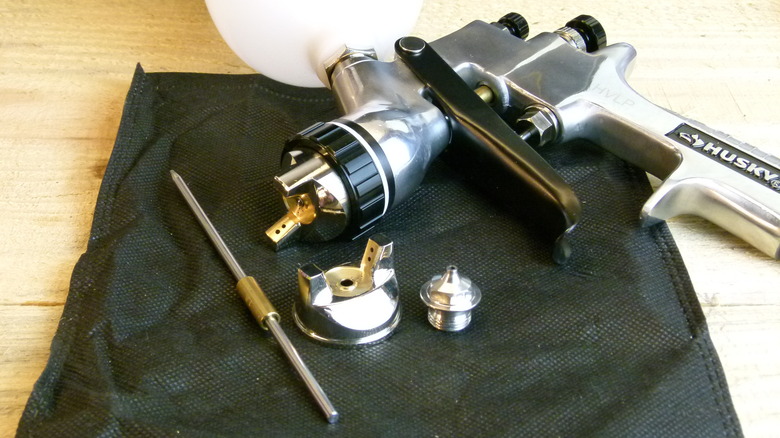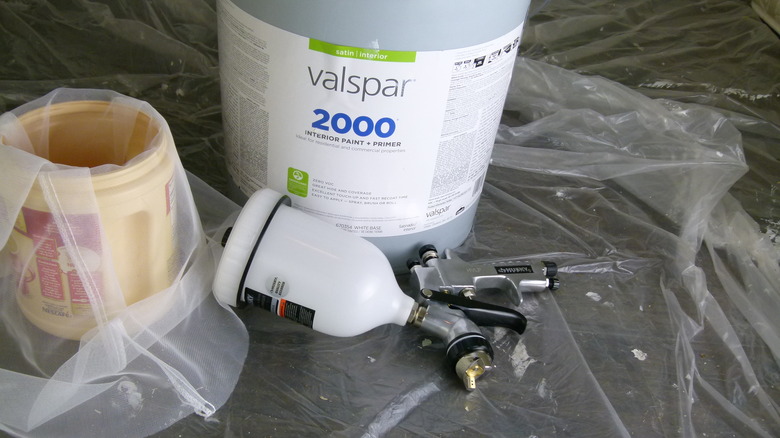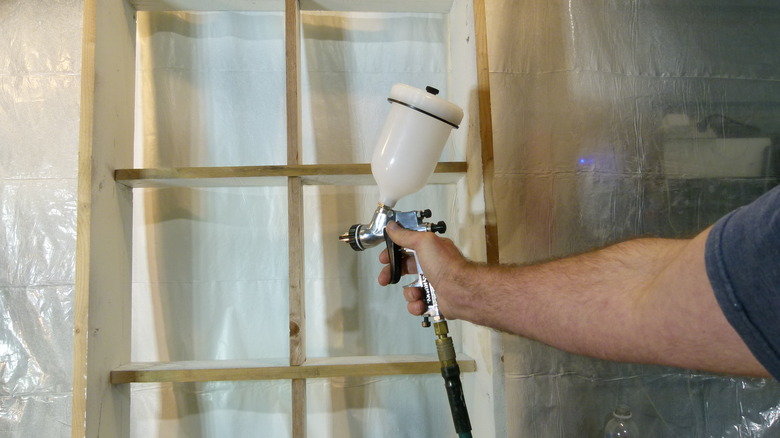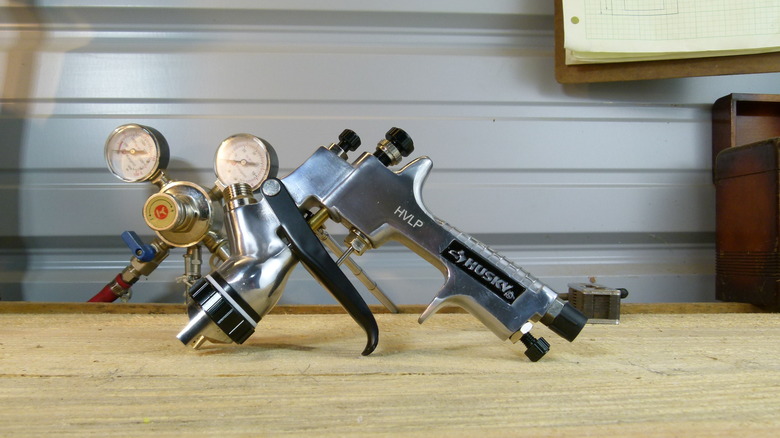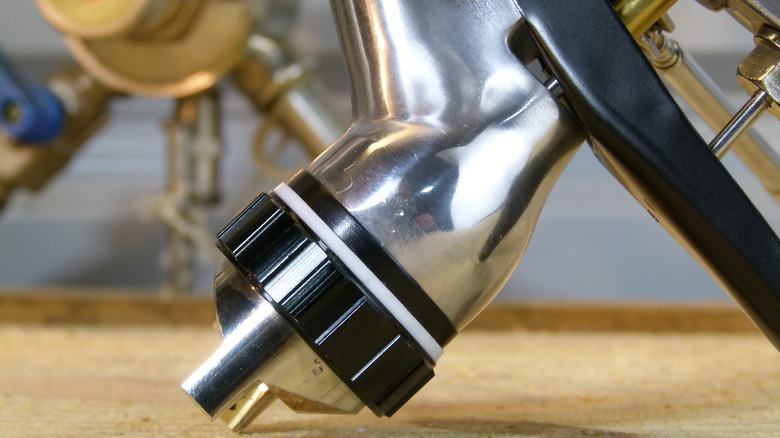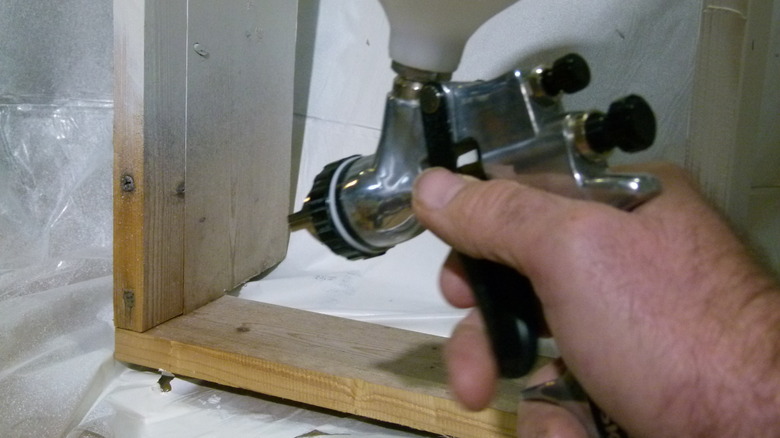We Tried The Cheapest Paint Sprayer At Home Depot. Here's How It Went.
We may receive a commission on purchases made from links.
For most people, or at least the most vocal people, painting your home is a job only slightly preferable but possibly related to digging your own grave. So when some advancement comes along to make it easier, it feels like a miracle cure. And when that cure fails, well, the disappointment can be powerful.
Enter the paint sprayer. Promising an end to the pain of painting since the 1880s, the paint sprayer evolved and expanded through a variety of industrial uses, says Paint Spray Pro. It took about 100 years to arrive at high volume, low pressure (HVLP) sprayers (which promise thinner coats, more even coverage, and less waste), and another 40 years for us to arrive at Home Depot to purchase one. Our mission was to find the cheapest model they sold, which turned out to be the $69.98 Husky Gravity Feed HVLP Spray Gun, model H4840GHVSG.
The first thing you notice when you get your hands on the HGFHVLPSG (or should we call it the H4840GHVSG?) is that it comes in an impossibly small box. This, you think, cannot possibly contain the cure for painting; maybe it's just some kind of palliative care device that keeps you painting until the very end. (In fact, we later tried to fit it back in the box, but couldn't.) The second thing you remark on, after prying open the box and laying out the contents, is that it has more parts than can be expected to simplify anything.
An overview of the Husky Gravity Feed HVLP Paint Gun
Still, for $70 it seems somehow impressive. It comes with two sizes of air caps, nozzles, fluid adjustment needles, a cleaning brush, a "socket spanner," and a wrench possibly modeled on Covenant weapons from the Halo franchise. And this is about the point where we started to worry about the promise of this cure, because a fairly thorough scouring of the included Use and Care Guide turned up no mention of any of these except the cleaning brush. Between the two wrenches, there are at least 11 hex bolt/nut openings you can use, but no explanation anywhere of which ones or why you might want to.
There's also a filter that isn't shown on the Package Contents at all, which turns out to be a paint filter that's large enough to trap the contents of a fast-food pepper packet, though no more. (Some suggest it's not necessary at all, given that you are supposed to strain the paint before even pouring it into the gun's cup.)
It is, maybe, unfair to grouse too much about modern product manuals, which are famously half-baked. Online reviewers of this spray gun rarely mention it, and instead generally remark either that it is good enough, or that it gets clogged almost immediately after you pause spraying. One reviewer did mention poor documentation, which neglects to mention a nut that is reverse-threaded for no discernible reason.
How we tested the Husky paint gun
In general, if you proceed with the correct air pressure, a sufficient compressor, an inline water filter, perhaps an inline air pressure regulator, paint of the correct viscosity, the correct distance and sweeping technique, and don't stop for a drink, very little can go wrong with a paint sprayer. Given this, we simply used the thing. Specifically, we set up the gun (finding the optimal fan shape/size, air pressure, and paint flow) using a few pieces of scrap plywood underlayment that we know to resist coverage unprimed.
Next we painted a roosting hutch salvaged from a pigeon house to use as workshop shelving, and partly painted a bedroom. Between each use, we let the gun sit for 20 minutes and then attempted to spray with it immediately. (20 minutes is about the upper limit review-writers said the gun can be idle before clogging.)
Although not by design, we did end up testing both 1.4- and 1.8-mm nozzles, as well as our paint choice both diluted and undiluted. We also used the gun with and without the paint filter that came with it ... also an unplanned improvisation. And we played around with the recommended 6- to 9-inch distance from nozzle to workpiece.
The idea was simply to determine what could be reliably done with an inexpensive HVLP paint sprayer. Is it practical for painting room interiors? House exteriors? Long privacy fences? Or just laying down lacquer on a guitar and other smallish items?
Patience pays off
Setting up the gun took longer than we anticipated, but this is not a negative. It seems to be a necessary step with any new paint job, and we found that once we dialed in all the correct settings and tweaks, the gun performed very well.
At first we couldn't get much paint from the gun at all, especially when the pattern control knob was set for the tallest fan. We adjusted the air pressure regulator up from 30 to 40 psi (the max recommended by Husky), and once again from 40 to 45 psi, and started seeing better results. After switching to the larger nozzle and fiddling with all three adjustment knobs for a while and not improving much, we consulted the manual about how much to thin paint for this sprayer. The Use and Care Guide has nothing specific to say on the topic, only that manufacturer's guidelines should be followed. So we thinned our Valspar 2000 paint+primer with 8oz of water per gallon, as detailed on the label. (Note that this is an acrylic paint; Husky warns repeatedly that trying to run latex through this gun isn't the sort of thing a decent person would do.)
After another moment's spraying, we suddenly started getting great results. We got great coverage with very little unwanted texture, and no overspray with one exception. This was partly a matter of finding a rhythm and distance (we aimed for about 7.5 inches) that matched our spray gun settings.
How the Husky paint gun could be improved
We did get some minor runs on the edges of the shelves we painted. This is clearly caused by slight overspray when painting the flat part of a shelf and reaching the edge of the board; the paint tends to collect on that edge. This seems unavoidable, and probably therefore more of an indication that shelves aren't an ideal application for HVLP spray guns than a real critique of Husky.
Our complaints about the spray gun itself are mostly quibbles. Remember the wrenches with 11 openings to fit bolts and nuts? Well, some of the sizes repeat, which made it a little vexing that none of the sizes matches the hex nut used to secure the paint cup in place. This is, after all, the very first thing most people will want to use a wrench for when using this sprayer. But that's not a big deal; we tightened the cup by hand and it worked flawlessly. It's also slightly absurd that this model doesn't come with fittings for attaching to a standard air hose. This is one of those things that prompts an unplanned and very irritating trip back to Home Depot for a $2 part you didn't know about.
Mostly, our complaints are about the manual. We've mentioned the mystery tools and alternative-sized parts that are not explained in the Use and Care Guide. It turns out to be both a little better, and far worse, than that.
So, about the manual ...
Consider this: If you were troubleshooting, after a little investigation you might uncover the fact that the fluid adjustment needle shown in the service parts diagram is apparently called a "tip" everywhere else in the manual. Even having unpuzzled that, there's still no explanation of why you might have two sizes (1.4 and 1.8 mm).This is not an isolated problem. The troubleshooting matrix, for example, says that several problems can be solved by lubricating or replacing the air valve stem. The trouble is that the service parts diagram contains no mention of a valve stem.
There are many such issues. The air hose illustration on page 5 highlights and enlarges a drawing of a quick coupler fitting that is both incorrect and impossible, and which is not mentioned at all in the accompanying text. This is rather like reading the manual for a cat collar and finding, without explanation, an enlargement of the tip of a drawn cat's tail, which is shown to terminate in a three-prong electrical plug.
Worse, instructions are generally insufficient or missing altogether. Perhaps the problem is that no one reads the manuals for cat collars or, for that matter, for paint sprayers — though we suspect this manual was a repurposed guide for another model, carelessly updated. But this is a complicated device with some complicated requirements, including a technique that is less than intuitive. A better manual would be a good way to express some regard for customers.
Our recommendation re: the Husky Gravity Feed HVLP Paint Gun
Setting the manual aside — which you should do as quickly as possible — this turns out to be a solid product. Most of the attention in the cheap spray gun market goes to Harbor Freight's offerings, but it's hard to imagine an entry-level gun being any easier to use successfully. The secret is simply surfing YouTube for videos about HVLP paint guns. (If you don't know how to find this kind of information on YouTube, borrow a 5-year-old. If you already have a 5-year-old, FYI, YouTube is that thing they're currently watching on your smart TV.)
Okay, sure, we are unbelievably displeased with the manual, which is more important than (for example) the fact that earlier versions of this gun included a handy air pressure regulator, while the H4840GHVSG comes with a new "ornamental ring" for the paint cup ... which we sincerely hope didn't add much to the price.
It probably wasn't malice that prompted Husky to issue such a hideous user manual, but a pro forma commitment informed by the fact that people commonly teach, overstimulate, and diagnose themselves with on-demand user-created content from sources like YouTube. And speaking of diagnosis, does this gun turn out to be a cure for painting? No, it's far too fiddly and time-consuming for that. But it does make painting more like a chronic ailment — and at least you know you can get an acceptable outcome in the end.
